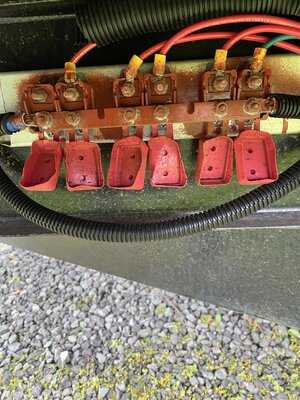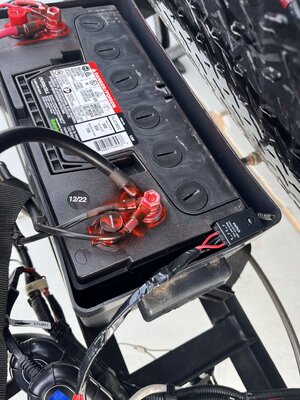This the 12v buss on the frame of my Mallard 210RB. 2022 model bought new in 2022.
Notice the covers on for the contacts are not on. I don’t believe they ever were on. Also notice the corrosion. Some sort of protective coating was applied, I presume at the factory.
Should I be worried about this?
Sub note: I am having problems with some of the 12v lights, bathroom fan and awning motor not working.
Dawg
It is not normal in my opinion and the condition of the wires appears to show corrosion moving up throught the wire and terminals. The corrosion will
create resistance in the circuit and will continue to move up through the wire worsening overtime and
eventually cause a voltage drop significant enough to cause a low voltage situation for certain circuits and effect the
operation of appliances being fed by it. In short, while
I don't know for certain it is causing your issue, in my opinion
it could cause it due to low voltage to the component. You can use a
DVOM to check for voltage at the light and then to check for the amount of voltage drop accross that circuit if you are handy with a DVOM (if not just take it a professional to have it diagnosed).
Also I do agree with the previous post, to clean it with battery cleaner and maybe wire brushing all the connections (I would probably clean up with emery cloth to make sure the connections are without any corrosion) because this would be a quick attempt to see if it will resolve your immediate problem. However, if it does not, then a voltage drop test will need to be performed to determine the integrity of the circuits so they can be repaired properly.
As for myself after cleaning I would:
1. Turn my
DVOM to the DC 20 volt setting.
2. Confirm the
12v lamp has
voltage present on the power input side going to it using the DVOM by placing the positive lead of the DVOM on the power input to the lamp and the negative lead to a good ground to see if 12v is present with the light turned off and if so, I would then go to the next step.
3. I would check the ground by disconnecting the lamp connector, connecting my
DVOM positive lead to the ground wire in that connector coming from the trailer to the lamp, and then connecting my
DVOM negative lead to a known good ground while my DVOM is on a to see if it had good continuity and less than 1 ohm resistance.
3. Turn on all the lamps for that circuit and then connect the
red DVOM lead (positive) directly to the power supply (one that is not corroded at the battery positive terminal that feeds the bar where the wires are connected).
4. Then connect the
negative DVOM lead to the
power input side of one of the lights while it is still plugged in and turned on.
5. I would note the
voltage drop accross the power side of the circuit and
if it exceeds 0.3v it is a problem and the circuit has too much resistance in it.
6. Next I would check the voltage drop at the power bar you sent a picture of by turning on all your rv lamps, then connect the
positive DVOM lead to the
positive battery terminal and then probe the wires coming off the bar about
6 inches back from where they
connect to the bar with the
negative lead of the DVOM just to see what I was losing right there. If it
exceeds 0.3v it can definitely cause an issue and has too much corrosion on the terminal and possibly in the wire. I would replace that small section of wire which feeds power to the lamps and recheck to confirm the voltage drop issue is resolved near the bar and retest the light to see if it resolved the issue. Note if when cutting the wire it appeared to have excessive corrosion in it (normally if this happens the insulation will look distorted, bumpy and swollen) I would continue to cut it back until it looked normal and would splice in the new wire section there.
A few things to consider is I have found on vehicles the amount of wire needing replacement when I have had issues with a voltage drop
varies depending on how far the corrosion has traveled up through the wire, sometimes you might just need to replace
a terminal end, sometimes several inches of wire, sometimes several feet, just depends on how far the corrosion has traveled. The voltage drop test will identify what all needs replacement.
A good circuit will have
0v to 0.3v voltage drop in my opinion.
When I used to be an automotive technician I would often
check battery cables this way when a
battery would show good voltage and pass a load test (12.6v unloaded battery voltage which drops to no less than 10v when starting a vehicle - you must always load the circuit when doing a voltage drop test), but the
vehicle's engine would turn over slowly, this way I could
determine if the issue was a
starter or
battery cable.
For more information just Google
Voltage Drop Test, you can probably find a video on it on Youtube.
Disclaimer: Above is what I would do, but I would recommend having a professional check it out to confirm where the issue lies. I am just trying to paint a picture of how I would go about checking it if I ran into your situation, hope this helps.













